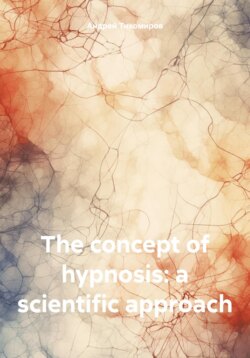The concept of hypnosis: a scientific approach

Реклама. ООО «ЛитРес», ИНН: 7719571260.
Оглавление
Андрей Тихомиров. The concept of hypnosis: a scientific approach
Introduction
From the history of hypnosis
The physiology of hypnosis
The use of hypnosis
Related books
Отрывок из книги
The words hypnosis and hypnotism both come from the term neurohypnosis (nervous sleep), they were all coined by Etienne Felix d'Henin de Cuvilliers in the 1820s. The term hypnosis comes from the Greek ὑπνος hypnos, "sleep", and the suffix -ωσις -osis, or from ὑπνόω hypnooō, "put to sleep" (the basis of aorist hypnōs-) and the suffix -is. These words were popularized in English by the Scottish surgeon James Brade (to whom they are sometimes mistakenly attributed) around 1841. Braid based his practice on a method developed by Franz Mesmer and his followers (which was called "mesmerism" or "animal magnetism"), but differed in his theory as to how the procedure worked. In ancient Russia, hypnosis was called "enchantment", and hypnotized people were called "charmed" or "enchanted".
Abbot Faria, a Catholic monk, was one of the pioneers of the scientific study of hypnosis, continuing the work of Franz Mesmer. Unlike Mesmer, who claimed that hypnosis was mediated by "animal magnetism," Faria believed that it worked solely through the power of suggestion. Soon hypnosis began to find its way into the world of modern medicine. The use of hypnosis in the medical field has become popular thanks to surgeons and therapists such as Elliotson and James Esdale, and researchers such as James Brade, who have helped uncover the biological and physical benefits of hypnosis. According to his writings, Brade began to hear reports of various Oriental meditation practices shortly after the publication of his first publication on hypnosis, Neuropnology (1843). He first discussed some of these Oriental practices in a series of articles entitled Magic, Mesmerism, Hypnotism, etc., from a historical and physiological point of view. He drew analogies between his own practice of hypnosis and various forms of Hindu yogic meditation, and other ancient spiritual practices, especially those involving voluntary burial and apparent hibernation of a person. Brade's interest in these practices stems from his study of Dabistan-i Mazahib, the "School of Religions", an ancient Persian text describing a wide range of Eastern religious rituals, beliefs and practices. Although he completely rejected the transcendental or metaphysical interpretation given to these phenomena, Braid acknowledged that these descriptions of Oriental practices confirm his opinion that the effects of hypnosis can be produced alone, without the presence of anyone else (as he had already proved to his own satisfaction by experiments that he conducted in November 1841); and he saw correlations between many "metaphysical" Oriental practices and his own "rational" neurohypnotism, and completely rejected all the fluid theories and magnetic practices of the Mesmerists.
.....
Franz Mesmer (1734-1815) believed that there is a magnetic force or "fluid" in the universe, called "animal magnetism", which affects the health of the human body. He experimented with magnets to influence this field to induce healing. By about 1774, he came to the conclusion that the same effect could be created by passing his hands in front of the subject's body, which would later be called "Mesmeric Passes".
In 1784, at the request of King Louis XVI, two royal commissions on animal magnetism were specifically commissioned (separately) to investigate the claims of a certain Charles d'Eslon (1750-1786), a disgruntled disciple of Mesmer, about the existence of an essential (and not metaphorical, as Mesmer assumed) "animal magnetism", "magnetic animal", and similarly a physical "magnetic fluid", "magnetic liquid". Among the researchers were scientist Antoine Lavoisier, electricity and terrestrial magnetism expert Benjamin Franklin and pain relief expert Joseph-Ignace Guillotin.
.....